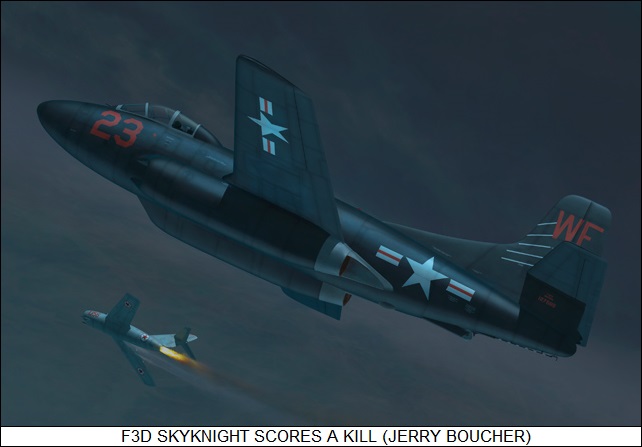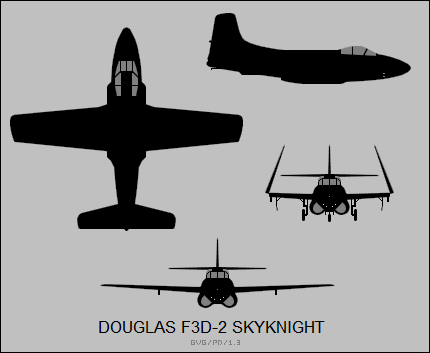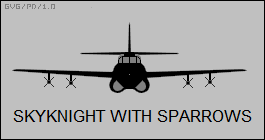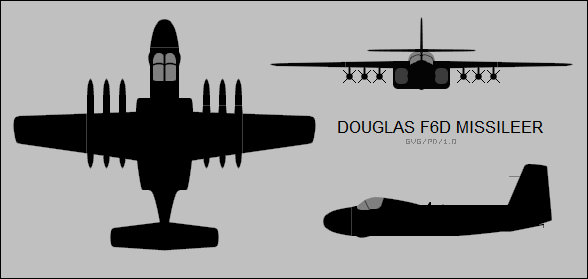
* The Douglas Skyknight was one of the first purpose-built jet night fighters; it served with distinction in the Korean War, and survived to put in useful service in the Vietnam War as well. This document provides a history and description of the Skyknight.

* In 1945, the US Navy began studies for a jet-powered carrier-based night fighter, resulting in issue of a request specifying a two-seat aircraft with long range radar and good performance. Douglas, Grumman, Curtiss, and Fleetwings submitted proposals, with Douglas awarded a contract on 3 April 1946 for delivery of three prototypes with the designation "XF3D-1 Skyknight". Notice the spelling was "Sky-Knight", not "Sky-Night".
Development was conducted by a team under the well-known Ed Heinemann at the Douglas division in El Segundo, California. The first prototype XF3D-1 made its initial flight on 23 March 1948, with test pilot Russell Thaw at the controls. All three prototypes were sent to Edwards Air Force Base in October 1948 for service trials. The Air Force was interested in the Skyknight for a time, since the Northrop F-89 Scorpion all-weather interceptor was suffering from development problems, but the USAF decided to acquire the Lockheed F-94 Starfire interceptor, a derivative of the Lockheed T-33 trainer, as an interim solution until the Scorpion's bugs were ironed out.
The Skyknight was of simple configuration, with:
A skid with a tiny wheel on the end was mounted in front of the arresting hook, and could be extended to protect the aircraft from bumping its tail on take-offs and landings. A hydraulically operated air brake was mounted on each side of the fuselage behind the wings.
The Skyknight was powered by twin Westinghouse J34-WE-22 turbojets with 13.3 kN (1,360 kgp / 3,000 lbf) thrust each, fitted in nacelles mounted low on the fuselage below the wings. The engines could be easily accessed for maintenance, and dropping them out for replacement was a simple procedure. However, it seems likely that the low position of the intakes made the aircraft vulnerable to runway foreign object ingestion. The aircraft was armed with four 20-millimeter cannon mounted in the underside of the nose, with 200 rounds per gun. Internal fuel capacity was 5,116 liters (1,350 US gallons). A 568-liter (150 US gallon) external tank or a 450-kilogram (1,000-pound) bomb could be carried under each wing.
The pilot and radar operator sat in a side-by-side configuration. The ejection seats available at the time could not work safely with such a seating arrangement, and an unusual escape mechanism was designed -- involving a chute in the floor behind the flight crew. Pulling a lever would blow off the rear half of the chute exit hatch in the belly between the engines, with the front half serving as a windbreak. Each crew member would then pivot around in his seat, grab a vaulting bar behind the seat, kick open a cockpit exit door, and slide out the chute feet-first, one crew member at a time. It wasn't a real ejection system, but it was better than nothing, if not very much.
Westinghouse AN/APQ-35 radar system was fitted in the nose. The first two prototypes had been fitted with the older SCR-720 radar, since the AN/APQ-35 hadn't been available at the time. The AN/APQ-35 actually consisted of two radars:
The AN/APS-21 could be used to locate a target, pass it over to the AN/APS-26 at close range for target tracking, and continue to scan for new targets. It was one of the first "track while scan" radar systems ever developed. Reliability was not the best, but that was often true for all complicated avionics systems of the era.
The prototype evaluation was successful, and led to an initial production order for 28 "F3D-1" Skyknights in June 1948. The first production F3D-1 flew on 13 February 1950, and the type went into operational service with the Navy VC-3 Squadron at Moffett Field, California, in December 1950.
BACK_TO_TOP* The F3D-1's airframe was similar to that of the XF3D-1, but it was fitted with a stronger tail bumper wheel, and fully operational electronic systems that increased the take-off weight by over two tonnes. It also featured uprated Westinghouse J34-WE-34 engines with 14.5 kN (1,475 kgp / 3,250 lbf) thrust each, the new engines requiring larger nacelles. A few early production F3D-1s were not fitted with the uprated powerplants due to engine non-availability.
The F3D-1 was still definitely underpowered, and only the initial batch of 28 were produced. The F3D-1s remained stateside and were used for training flight crew for the definitive Skyknight variant, the "F3D-2".
The F3D-2 was ordered in August 1949. The F3D-2 was originally planned to be powered by twin Westinghouse J46-WE-3 turbojets with 20.5 kN (2,090 kgp / 4,600 lbf) thrust each. Unfortunately, development of the J46 proved troublesome, and so the F3D-2 was completed with still further uprated J34-WE-36/36A turbojets with 15.1 kN (1,540 kgp / 3,400 lbf) thrust each -- less powerful than the J46s, but still an improvement.
___________________________________________________________________
DOUGLAS F3D-2 SKYKNIGHT:
___________________________________________________________________
wingspan:
15.24 meters (50 feet)
wing area:
37.16 sq_meters (400 sq_feet)
length:
13.87 meters (45 feet 6 inches)
height:
4.9 meters (16 feet 1 inch)
empty weight:
8,240 kilograms (18,160 pounds)
max loaded weight:
12,180 kilograms (28,850 pounds)
maximum speed:
910 KPH (565 MPH / 490 KT)
service ceiling:
11,650 meters (38,200 feet)
range:
1,930 kilometers (1,200 MI / 1,040 NMI)
___________________________________________________________________
The first F3D-2 flew on 14 February 1951. The F3D-2's most visible external difference from the F3D-1 was larger engine air intakes, provided to allow greater airflow for the planned J46 turbojets. A spoiler system was added to permit tighter turns and a higher roll rate, and an AN/APS-28 tail-warning radar was also fitted. The AN/APS-28 was a relatively sophisticated sensor, with a range of 6.5 kilometers (4 miles) and the ability to give range, azimuth, and elevation information. Other improvements included a General Electric G-3 autopilot, thicker windscreen armor glass, and more effective air conditioning.

* A total of 237 F3D-2s was built, with the last produced in March 1952. The Skyknight served with a number of US Navy and Marine squadrons, generally off of land bases. It was nicknamed "Willie the Whale" for its less-than-sleek appearance. Marine Squadron VMF(N)-513 was sent to Kunsan, Korea, with their Skyknights in the spring of 1952, where the type served with distinction.
The USAF had operated Boeing B-29 Superfortress heavy bombers on daylight raids over enemy territory early in the war, but suffered excessive losses to North Korean MiG-15s, and so the bombers switched to night attacks, their losses then declining considerably. However, by late 1951, the enemy had refined their ability to direct MiG-15s against the Superfortresses using ground radar control, and losses began to rise again. USAF F-94B Starfire night fighters were put into service to protect the bombers, but for various reasons they did not prove satisfactory in this role. Marine Skyknights were pressed into service as night escorts instead and performed the mission very well.
While the Skyknight was not as aerodynamically advanced as the sleek MiG-15 and did not have an excess of engine thrust by any means, its four cannon packed a hefty punch, and it could easily out-turn a MiG-15 whose pilot was foolish enough to get into a turning contest. Probably the biggest factor in the Skyknight's favor was that the MiG-15 did not have search radar, being directed to targets at night under ground radar control; in a night fight, the MiG pilot was largely blind, while the Skyknight crew could "see" perfectly well.
On the night of 2:3 November 1952, a Skyknight piloted by Marine Major William Stratton, accompanied by radar operator Master Sergeant Hans Hoagland, shot down what they reported from the exhaust pattern to be a Yak-15 fighter, and claimed a confirmed kill since the Skyknight flew through debris, narrowly evading damage. Russian records indicate the target was actually a MiG-15 -- the Yak-15 was really not suited for operational use, and wasn't used in combat in Korea or anywhere else -- and though the Skyknight set the MiG on fire, the pilot managed to extinguish the flames and get back to base. The MiG was fully operational in a few days, a tribute to its rugged construction. However, five days later, on the night of 7:8 November, another Skyknight under the command of Marine Captain Oliver R. Davis with radar operator Warrant Officer D.F. "Ding" Fessler shot down a MiG-15. Russian sources do confirm this kill and that the pilot, a Lieutenant Kovalyov, ejected safely.
On 10 December 1952, a Skyknight piloted by Marine Lieutenant Joseph Corvi with radar operator Sergeant Dan George spotted a "bogey" on radar. They could not establish visual contact, but since no "friendlies" were supposed to be in the area, they fired on the target. A kill was confirmed when Sergeant George spotted a wing tumbling past them. It turned out to be one of the little Po-2 biplanes used by the North Koreans to harass UN forces at night. The Po-2 was a difficult target, since it flew low and slow, it was small and agile, and its mostly wooden construction did not show up well on radar.
The Marine Skyknights claimed a total of at least six kills, and no B-29s under their escort were lost to enemy fighters. Two Skyknights were lost in action for unknown causes.
BACK_TO_TOP* An F3D-3 with swept wings and J46 engines was planned, with a contract placed for a large number of aircraft. Unfortunately, the delays in the J46 program meant that the J34 engine would have to be used, and studies demonstrated that, with J34 engines, the F3D-3 would show little performance improvement over the F3D-2. The order was canceled in early 1952. There was no further new production of Skyknights.

The Skyknight was clearly a first-generation jet fighter, and as such was quickly pulled out of first-line service after the Korean War, to be replaced by more sophisticated aircraft such as the Douglas F4D Skyray. However, the type was updated and converted to various alternative uses:
According to other reports by aircrew, the Skyknight was very well suited for use as a trials or countermeasures platform, since it had a large equipment bay in the fuselage, accessed through a door in the belly and big enough to allow a technician to stand up.

* In 1962, the US military consolidated their aircraft designation schemes, and Skyknight variants still in operation were redesignated as follows:
In 1965, the US began to ramp up the air war against North Vietnam, and the US military found itself short of countermeasures aircraft to protect strike packages. The EF-10B was one of the few assets on hand, and in April 1965 a handful of them were sent to Da Nang airbase in South Vietnam to support both US Navy and US Air Force raids over North Vietnam.
There were never more than about ten EF-10Bs available; they were sent on numerous "Fogbound" missions, pinning down the locations of enemy radar stations and passing off their coordinates for attack by defense-suppression aircraft, or blinding the radars with chaff and electronic jammers. Despite their age, the EF-10Bs were still effective, and they were heavily tasked well into 1966. By late 1966, Douglas RB-66 Destroyers were taking over the countermeasures role for the Air Force, with the EKA-3B Skywarrior and later the EA-6A Prowler taking over countermeasures for the Navy. However, some EF-10Bs were upgraded with new avionics in 1967, being known as "Super Whales". The Marine EF-10Bs continued to fly in Vietnam until 1969; the type was finally removed from operational service in 1970.
A number of TF-10Bs were used as test and trials platforms into the early 1980s. These aircraft were the victims of bizarre Frankenstein modifications, with noses of other aircraft such as the Douglas Skyhawk grafted on to perform tests of radar systems. No Skyknights are now in flying condition, though a number are in static display in museums and US military bases.
* The following list gives Skyknight variants and production:
* In the late 1950s, Douglas worked on a follow-on of sorts to the Skyknight, the "F6D Missileer". It grew out of US Navy worries in the later 1950s about fleet air defense, aggravated by the Soviet development of antiship missiles that could be used to attack a carrier group; defense against such high-speed missiles was clearly problematic.
One part of the solution to the problem was a carrier-based radar airborne early warning (AEW) aircraft. That wasn't a new concept, the Navy having operated such from just after the end of World War II, beginning with the Grumman TBM-3W -- a serious modification of the Avenger torpedo bomber -- and culminating in the 1960s with the Grumman E-2 Hawkeye. However, an AEW aircraft could only give warning; the AEW aircraft had to be linked to a weapons platform that could destroy the threats.
In 1957, the US Navy began work on what was known as a "fleet defense fighter". It wasn't to be a fighter in the traditional sense of the word; it was essentially a flying AAM carrier, with long-range AAM armament, powerful radar, and long endurance. It didn't need to be a dogfighter, and so the Navy specified subsonic performance -- a backwards-seeming step in an era when Mach 2 performance was regarded as all but mandatory for a combat aircraft.
The fleet defense fighter was a "weapons system", necessarily involving three development programs: one for the AAMs, one for the radar, and one for the aircraft itself:
The F6D had a configurational resemblance to the Skyknight, featuring a side-by-side cockpit for pilot and radar operator, twin podded engines, and straight flight surfaces. The wings were mounted high instead of at mid-fuselage, though they still folded up at mid-span. Three Eagle AAMs could be carried on pylons under each wing, plus two on the belly, for a total of eight missiles. The Missileer was to be powered by a non-afterburning version of the new Pratt & Whitney TF30 bypass turbojet. The F6D would have tricycle landing gear, all gear assemblies with twin wheels, the main gear tucking into the fuselage, and a stinger-type arresting hook. Presumably the Missileer had ejection seats; it is unclear if the radar operator had secondary flight controls, which would have come in handy to spell the pilot every now and then.
___________________________________________________________________
DOUGLAS F6D MISSILEER:
___________________________________________________________________
wingspan:
21.33 meters (70 feet)
wing area:
58.52 sq_meters (630 sq_feet)
length:
16.15 meters (53 feet)
height:
5.51 meters (18 feet 1 inch)
loaded weight:
22,680 kilograms (50,000 pounds)
maximum speed:
885 KPH (550 MPH / 480 KT)
___________________________________________________________________
Some sources claim that there were doubts from the outset about the F6D, since it was clearly not an air-superiority fighter as such -- but that was understood in the specification, it was only intended to be a long-range air-defense platform. In principle, dogfighting wasn't a concern because the Eagle missile would destroy intruders before they knew what hit them; the expected adversaries were Soviet missile carrier aircraft and antiship missiles, the missiles possibly launched from Soviet warships or submarines, meaning dogfighting was irrelevant anyway. If dogfighting was required, the Navy was acquiring other assets, such as the Vought F8U Crusader, for that job.

However, the Missileer program was obviously going to be costly, and so the outgoing Eisenhower Administration was unenthusiastic about pushing it, preferring to leave the decision to invest in the program to the next presidency. When the Kennedy Administration took office in early 1961, the new defense secretary, Robert McNamara, was big on "commonality" between the US armed services; he felt that the Navy's fleet defense fighter could be developed as a variant of the Air Force's General Dynamics F-111 strike fighter, the Navy variant being designated the "F-111B". Of course, the Missileer was canceled without ever being flown.
The F-111B would turn out to be a fiasco, and would never serve with the US Navy; when the F-111B program collapsed, Grumman -- which had been developing the F-111B as a subcontractor to General Dynamics -- offered an alternative design for a fleet defense fighter. It would emerge as the "F-14 Tomcat", armed with the Hughes AIM-54 Phoenix long-range AAM, the name of "Phoenix" apparently hinting at a resurrection of the "Eagle", guided by Hughes AN/AWG-9 radar, originally developed for the F-111B. However, that is another story.
It is difficult in hindsight to know if the F6D was a good idea or not. Certainly, nobody would have ever considered it a fighter, but a carrier-based "flying truck" would have had a range of applications of its own, such as tanker or EW platform -- a flexibility eventually demonstrated by an operational Navy "flying truck", the Lockheed S-3 Viking. The Missileer having never come close to flying, speculation is all we have left.
BACK_TO_TOP* Despite the fact that most sources speak well of the Skyknight, one US Marine familiar with the aircraft from his Vietnam days said on an Internet bulletin board that it was known as the "Drut" -- a term whose meaning can be deciphered by reading it backwards. Some claim that this unflattering nickname was obtained from the escape system, with the crew "flushed out" of the cockpit backwards through the escape chute. However, the age and obsolescence of the Skyknight by the Vietnam era might have had something to do with it as well.
* All my aviation documents are written from secondary sources, and while this is adequate to give a fairly clear description of an aircraft, there are generally a few contradictions and fuzzy points. In the case of the Skyknight, descriptions of the AN/APQ-35 radar system are confusing and contrary, particularly since it actually consisted of two separate radars, the AN/APS-21 and AN/APS-26, working in conjunction. Range figures also vary widely from source to source; as it turns out, radar range has to be specified relative to the size of a target, and not surprisingly a radar can pick up a heavy bomber from much farther away than it can pick up a fighter. I use conservative range specifications in this document.

* Sources include:
A very thorough website document on the Skyknight by aviation enthusiast Joe Baugher was also consulted for additional details.
* Revision history:
v1.0 / 01 feb 01 v1.0.1 / 01 sep 02 / Review & polish. v1.0.2 / 01 sep 04 / Review & polish. v1.0.3 / 01 aug 06 / Review & polish. v1.0.4 / 01 aug 08 / Review & polish. v1.0.5 / 01 jul 10 / Review & polish. v1.0.6 / 01 aug 11 / Review & polish. v2.0.0 / 01 jul 13 / Added F6D Missileer. v2.0.1 / 01 dec 13 / Review & polish. v2.0.2 / 01 nov 15 / Review & polish. v2.0.3 / 01 oct 17 / Review & polish. v2.0.4 / 01 sep 19 / Review & polish. v2.0.5 / 01 jul 21 / Review & polish. v2.0.6 / 01 jun 23 / Review & polish. v2.0.7 / 01 jun 25 / Review & polish.BACK_TO_TOP
